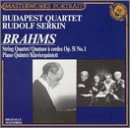| All Artists: Brahms, Budapest String Quartet Title: String Quartet Members Wishing: 2 Total Copies: 0 Label: Sony Original Release Date: 1/1/1992 Re-Release Date: 7/28/1992 Genre: Classical Style: Chamber Music Number of Discs: 1 SwapaCD Credits: 1 UPCs: 014644568628, 074644568622 |
Search - Brahms, Budapest String Quartet :: String Quartet
 | Brahms, Budapest String Quartet String Quartet Genre: Classical
|
Larger Image |
CD Details |
CD ReviewsA collector item! Hiram Gomez Pardo | Valencia, Venezuela | 08/24/2005 (5 out of 5 stars) "Budapest String Quartet: Joseph Roisman & Alexander Schneider, Violins, Boris Kroyt, Viola, Misha Schneider, Cello.
I would like to express briefly that if you want to go to the musical roots of Johannes Brahms, start by his chamber works and then by the Symphonies. The reason is very simple. The huge pressure exerted by the public opinion in the sense he was the expected descendent of Beethoven marked in his spirit indelible traces. In fact he had for the Op. 48 to compose his first Symphony. That's why in the chamber work genre he felt possibly more secure and even free to innovate and not continue as in the case of the Symphonic genre the path of Ludwig van. Budapest String Quartet has become -through the years- a vital and obligated reference at the moment all of us who love the intimate music must decide to acquire a chamber piece. They had the perfect synchronization, the accurate harmony, the expected tonal balance and that unequally Style immediately recognizable. The String Quartet in C minor Opus 51 has always been considered one of Brahms's solemn and introspective works. Brahms finished it in 1873, when he was forty and represents a true example of effort and dedication. It has a visible symphonic accent. The first movement is a musical foretell of Richard Straussian' style. The second movement is tender-hearted movement of contemplative character, that reminds us the Beethoven's Cavatina of Op. 130 Quartet. The third movement is scherzo with marked nostalgic and reminiscent gaze. The last one is oddly built burdened of dramatic atmosphere. This performance was recorded at Columbia Recording Studios, New York City, November 14 & 16, 1963. And now we have come to one of the most notable chamber works ever written. To my mind this chamber work genre share honors with Dvorak's expressive Op. 81 and lovely Mozart's E flat major Quintet Kv. 452, but if you requested me what is my favorite I would name this Brahmsian jewel. Once more we must confess the wonderful rapport among Rudolf Serkin and the members of the Budapest ensemble. The First movement raids violently with a luxurious theme loaded with a visible anguish, impregnated of visible Hungarian moods, superbly built. Serkin plays with such conviction level and supreme involvement that lets you absolutely mesmerized. The second is a kind and summer breeze Andante, plenty of blithe spirits. The third once more is supported by an arresting gypsy melody with tragic accent (beneath the moving and apparent happy rapture) as well he had done it successfully with the Finale of his previous Opus 25 Quartet. In the last movement, Brahms insists with a Hungarian Folk theme with a very inspired final. Recorded at Marlboro, Vermont, September, 8 & 9, 1963. " |

 Track Listings (8) - Disc #1
Track Listings (8) - Disc #1